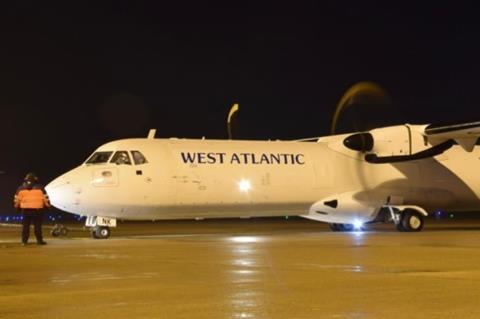Cargo operator West Atlantic is enhancing its crosswind training for crews after an incident in which an ATR 72-200 freighter swerved from the centreline and hit runway edge lights with its nose-gear while landing at East Midlands in the UK.
The turboprop was arriving from Jersey in darkness on 25 October last year, approaching runway 09 with winds from the southeast at 10kt – giving a crosswind component from the right.
Although the approach and touchdown were stable, and the ATR rolled out aligned with the runway, it abruptly veered 10° to the right as it decelerated through 80kt.
The captain handed control to the first officer and applied left nose-wheel steering to straighten the track, noticing that the right wing was lifting.
Further left-hand steering, supported by left pedal and differential brake input by the first officer, resulted in the aircraft’s slowly responding. But the aircraft (G-CLNK) was found to have nose-wheel tyre damage and a runway inspection found a broken edge light.

The captain had recently converted to the ATR from the British Aerospace ATP, on which he routinely used the steering tiller during the landing roll at 80kt to maintain direction.
Analysis of the landing roll showed there was probably “insufficient” into-wind aileron applied, resulting in the upwind wing’s lifting and leading the ATR to turn into the wind.
“The initial attempt to correct the turn by nose-wheel steering through the use of the tiller, rather than by use of rudder to maintain directional control, also likely contributed to the runway excursion,” says the UK Air Accidents Investigation Branch.
According to the inquiry the carrier has rewritten its conversion course to “maximise” crew exposure to crosswinds, and advised all personnel involved in ATR 72 training to monitor for incorrect crosswind or nose-wheel steering techniques.

























